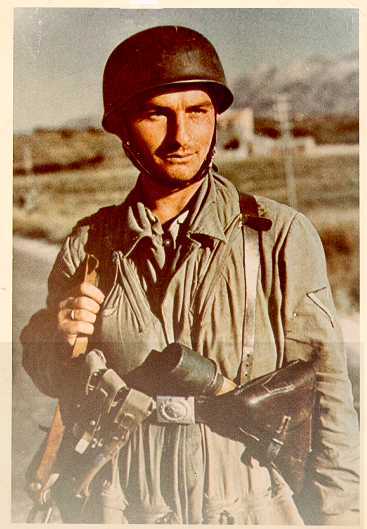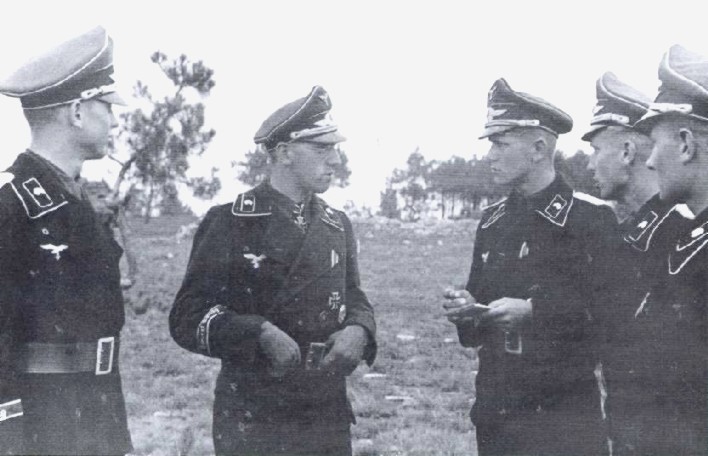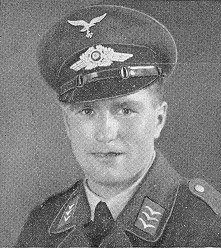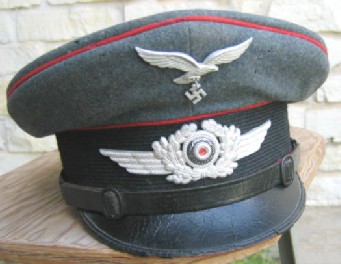Paratroopers - Fallschrimjager
The German paratroopers were
organized
from
a cadre of troops of the Herman Goring Regiment who had been trained to
use parachutes. The paratrooper units were enlarged and
grew.
The climax of the German paratrooper was during the campaign to take
control
of Crete. Here the paratroopers were successfully used but their
casualties were heavy due to anti-aircraft fire. Many aicraft
where
shot down. Paratroopers were used to strengthen their defenses of
Sicily. Sicily was the site of a unique "first"--this was the
first
time paratroopers of opposing forces, this case it was German and US,
to
jump into the same battle at the same time.
After their tremendous
losses and
after the decline of the German air forces, and especially the loss of
their larger troop-carrying aircraft, the German paratroopers were
relegated
to fighting as light infantrymen---however well trained and motivated
infantrymen.
By June of 1944, there were 150,000 paratroopers but only 30,000 were
jump
trained.
Part of the reason
the
paratroopers
were not deployed more was because of their poor equipemtn. The
German
used the Ruckenpackung Zwangauslosung RZ-16 or RZ-20
parachute.
Its risers connected at four points, two at the hips and two at the
shoulders.
This caused the paratrooper to land in a face-down position, which
required
elbow and knee pads for protection. The parachute was hard to
control,
especially in cross-winds and limited the amount of equipment that
could
be carried.
Battle of the Bulge
-
Operation
Stoesser(Falcon) - The last large use of German paratroopers in
an
airborne assault was on December 17, 1944. The 3rd Parachute
Division,
consisting of the 5th, 8th, and 9th Parachute Regiments, were used in
the
Ardene offensive. They were led by Major August van der
Heydte.
Their drop zone was 11km north of Malmedy and their objective was
a cross-road junction. The assault began with 112 Ju-52 troop
carriers
that also carried 300 straw dummies. However, only 10 aircraft
made
it to the drop zone. Some paratroopers landed 50 miles behind
German
lines and some landed in Holland. Remember this was in the middle
of winter and the area was blanketed by a low cloud cover. Only 125
made
it to the drop zone; about 1/10 the original force. If they can
claim
any success it was in the fact that the paratroopers and the German
spys
dressed as Americans created confusion and expenditure of resources to
guard the rear areas.
|
Chronology of the
Paratrooper Divisions
1938 -
Paratrooper
battalion transferred to 7th Flieger Division to form the 1st
Battalion, 1st Fallschirmjager Regiment.
1943 Sept -
Gen
Skorsensky
and troops of 7th Fallschrimjager carry out a daring rescue of
Mussolini.
1943 Nov
- 4th
Fallschrimjager
Division formed from 2nd FJ Division and Italian paratroopers.
1944 Jan
- 4th
Fallschrimjager
Division and HG Division attack at Anzio
1944 June -
Normandy
invasion.
6th FJ Regiment under Maj. Frederick von der Heydte is deployed at
Caraten. II
Fallschrim Korps moved to Normandy: 3rd FJ Division at St. Lo and
5th
FJ Division outside Caen.
1944 Dec 17 - 3rd
Fallschrimjager
Division is deployed in an air assault in the Ardene Offensive
(i.e.
Battle of the Bulge).
|
Paratrooper
units in Italy Two
of the 15 paratrooper
divisions served in Italy.
1ST PARACHUTE CORPS
I Parachute Corps, lead by General der Fallschirmtruppen Alfred
Schlemm, consisted of only one parachute division, the 4th
Parachute
Division, and some infantry divisions and a panzer-grenadier
division.
General der Fallschirmtruppen Richard Heidrich was commander
after
Nov 1944. I Parachute Corps served in Italy from Jan 1944 - May
1945.
The 4th Parachute Division was formed from the 2nd
Parachute
Division and the Italian paratroopers.
4TH PARACHUTE
DIVISION
Generalleutnant HeinrichTrettner
10th, 11th, and 12th Parachute Infantry regiments
4th Parachute AAA Battalion (motorized)
4th Parachute Mortar Battalion
4th Parachute Panzerjäger Battalion
4th Parachute Artillery Regiment
4th Parachute Flak Battalion
4th Parachute Pioneer Battalion
4th Parachute Signals Battalion
The 1st Parachute Division served at Sicily, July
1943 -
Sept
1943. It served under LI Mountain Corps from Sept 1943 -
May
1945.
1ST PARACHUTE
DIVISION General
der
Fallschirmtruppe Richard Heidrich
1st, 3d, and 4th Parachute Infantry regiments
13. Parachute Nebelwerfer Company
14. Parachute Panzerjäger Company
1st Parachute Machinegun Regiment
1st Parachute Antitank Battalion
1st Parachute Artillery Regiment
1st Parachute Panzerjager Battalion
1st Parachute Pioneer Battalion
1st Medical Battalion
|
 |
Fallschrimjager
- 1942
Taken during Crete assault.
He is wearing smock
and
standard
paratrooper helmet worn by paratroopers.
Corporal chevron rank on
left sleeve
and Luftwaffe eagle under his right hand. Luftwaffe belt buckle(oval
center
with eagle) on belt supported by suspenders. Armed with a Model P08 Luger pistol ,
a stick
grenade, and ammo pouches for the MP-40 Schmeisser machine-gun(draped
over
his right shoulder).
Photo is one of a
group of
color photos
purchased from a mail order in the 1960's.
|
Return to Top
Menu
|
|
Herman Goring Panzer
Division
Originally
a small police battalion organized by the then Secretary of Interior,
Herman
Goring, it grew in size to a regiment. The primary function of
the
regiment at the beginning of the war was a flak unit and later grew to
a armored troops. Its designation became Fallschrimjager
PanzerKorps Herman Goring, which translates to a puzzleing
name
of "Parachutist Armor Corps". Here is a short history.
In
February 1933, Hermann Goring as Minister of Interior created the
Police
Battalion Wecke. By 1935 it had become the "General Goring State
Police Group" and began to adapt military training.
This
resulted in it being assigned to the Luftwaffe as the "General
Goring
Regiment". By 1938 the role of the regiment consisted primarily
of
flak batteries and searchlight battalions but still retained a
motorcycle
company and a guard battalion. These special guards were used at
Goring's forrest estate at Karinhall and on special occasions such as
Air
Force day and Richtohofen's Memorial parades.
In 1936, General Goring selected 36 soliders to perform a parachute
demonstration
jump. From this, 600 recruits were selected to go through
training
and were the first German paratroopers. On 1 July 1938, General
Kurt
Student organized the "Fallshirmtruppe" into the "7th Aviation
Division"
in order to conceal their true purpose. The Hermann Goring Regiment was
reorganized on 1 October 1939 to include a Parachute Rifle Battalion
("Fallschrimschutze"),
which was later absorbed into the Luftwaffe's 1st Parachute Regiment
and
called "Fallschirmjager". That was the only time the Herman Goring
troops
were used as paratroopers, EVEN THOUGH they retained the term
"Fallschrim"
in their title.
One battalion formed from the flak units became the Fuhrer Flak
Battalion.
This battalion was first used as as a special train escort on the
Fuhrer's
trip to Poland and as flak protection at his "Wolf's Lair" in E.
Prussia.
Later, it was organized into a regiment and eventually became the
Fuhrer
Escort Division.
At the outbreak of war the HG Regiment fought in Poland.
Reorganized
into the HG Division, they were sent to Italy for about one year.
On 6 January, 1944, the division was renamed "Fallschirm Panzer
Division
Hermann Goring" that consisted of panzer, armored artillery and
infantry
battalions. They were sent back to Poland and fought in the
battle
of Warsaw in August 1944. They served in Russia with the XXXIX
Panzer
Corps and at Fortress Graudenz in February 1945.
During
the fighting in Russia, the Henrich Goring, the nephew of the
Reichsmarshall,
was killed in action.
The
statistics
indicate
that 60,000 soldiers served with the HG Division during its
life-span.
After the surrender in 1945, only 15,000 survivors remained. An
estimated
90% of the soldiers who fought on the Eastern Front were casualties.

|
Chronology of the
Herman
Goring
Division
1933 -
Goring in charge
of Prussian Police Force. He created Polizeiabteilung 'Wecke' (Police
Detachment).
1934 - Renamed
Landespolizeigruppe
'Wecke' (Provisional Police Group)
1935 - Renamed
Landespolizeigruppe
'General Goring' . Gen Goring placed in command of the newly formed
Luftwaffee.
1936 - Renamed
Regiment 'General
Goring'. Goring arranged a demonstration parachute jump. 600 recruits
joined
up for training and created a Fallschirmshutzen Battalion.
1938 - Paratrooper
battalion
transferred to 7th Flieger Division to form the 1st Battalion, 1st
Fallschirmjager
Regiment.
1942 Mar - Regiment
General Goring
expanded to Herman Goring Brigade, commanded by Conrath.
1942 Dec - First
elements of
flak regiment was sent to N. Africa.
1943 Jan - Expands to
Fallschrim
Division Herman Goring commanded my Major General Conrath.
1943 July - HG
Division called
to Sicily and fights around Catania airfield and Primasole Bridge.
1943 Sept - Salerno
Invasion.
Part of HG unit called to defend north of Salerno.
1943 Oct - HG
Division pulls
out of line for rest at Cassino.
Obst Lt. Julius
Schlegelrescues
the art work out of Monte Cassino.
1944 Jan - HG
Division and 4th
FJ Division attack at Anzio
1944 Mar - HG
Division pulled
out for rest. Reformed as an armored infantry and renamed 1st
Fallschrim-Panzer
Division 'Herman Goring'.
1944 May - HG
Division rushed
to breach the Allies break out at Anzio.
1944 July - HG
Division leaves
Italy
1945 Jan - Two HG
Divisions are
encircled. Some manage to fight their way out & evacuated by sea.
|
|
|
Organizational Table
Herman
Goring
Division
Defense of Salerno, September
1943
Hermann Göring Panzer Division (Lt-Gen.
Schmalz)
Panzer
Regiment
HG (Oberst Roth)
HQ Company
II. Battalion
III. Battalion (StuG)
Tank Strength :
PzIV(Lang) : 31
PzIIIL : 25
PzIIIN : 3
StuGIIIG : 16
StuH42 : 6
PzBefehlwagen : 3
Panzergrenadier
Regiment HG 1 (Oberst Kluge)
I. Battalion (Mechanised)
II. Battalion (Motorised)
III. Battalion (Motorised)
13. Company (6 x 150mm sIG, mechanised)
14. Company (Engineers, motorised)
Panzergrenadier
Regiment HG 2 (Oberst von Necker)
I. Battalion (Motorised)
II. Battalion (Motorised)
III. Battalion (Motorised)
13. Company (6 x 150mm sIG, motorised)
15. Company (9 x SdKfz 10/4)
Panzer-Artillery
Regiment HG
I. Battalion (12 x Wespe + 6 x Hummel)
II. Battalion (12 x 105mm leFH, motorised)
III. Battalion (12 x 150mm sFH, mechanised)
IV. Battalion (12 x 150mm NbW41 + 4 x 150mm sFH, motorised)
Flak
Regiment
HG
I. Battalion
1. Company (4 x 88mm FlaK18 + 3 37mm FlaK43)
2. Company (4 x 88mm FlaK18 + 3 37mm FlaK43)
3. Company (4 x 88mm FlaK18 + 3 37mm FlaK43)
4. Company (12 x SdKfz 10/4, 4 x SdKfz 7/1)
5. Company (12 x SdKfz 10/4, 4 x SdKfz 7/1)
II. Battalion
6. Company (4 x 88mm FlaK18 + 3 37mm FlaK43)
7. Company (4 x 88mm FlaK18 + 3 37mm FlaK43)
8. Company (4 x 88mm FlaK18 + 3 37mm FlaK43)
9. Company (12 x SdKfz 10/4, 4 x SdKfz 7/1)
10. Company (12 x SdKfz 10/4, 4 x SdKfz 7/1)
Führer FlaK Abteilung
1. Company (12 x SdKfz 6/2)
2. Company (12 x SdKfz 6/2)
3. Company (12 x SdKfz 6/2)
Armored
Recon
Abteilung HG
1. Company (8 x SdKfz.234/1, 6 x SdKfz.222, 4 x SdKfz.231/3)
2. Company (Infantry, motorised)
3. Company (Infantry, mechanised)
4. Company (2 x 75mm leIG, 3 x 50mmPaK38, 4 x HMG)
Panzer
Pioneer
Abteilung HG (Hauptman Bittig)
1. Company (Motorised)
2. Company (Motorised)
3. Company (Motorised)

Group of officers in late
1944.
Central
figure is Major Karl Russman wearing
a Knights Cross around his neck.
Each officer is wearing the black
tanker's
uniform with collar insignia of a panzer skull,
the Luftwaffee eagle on the
breast
and a "GENERAL GORING" armband on right cuff.
The visor caps are standard
Luftwaffee
pattern and color. Also note the ribbon
for the Iron Cross 2nd Class is
worn through the button hole on the corner of the lapel.
{Photo is from "The History of the Fallschirm-Panzerkorps Hermann
Goring"
- Franz Kurowski}
Return
to Top
Menu
|
Luftwaffe Field
Division
A Brief History
of the 19th and 20th Luftwaffe
Field Divisions - the two divisions that served
in Italy.
The 19th and
20th Luftwaffe Field Divisions(LFD)
were part of the 3rd wave of infantry divisions formed from air force
personel in France in March 1943. Recruits and officers came from
the XIII FliegerKorps. Flieger-Regiment 23 was a training unit
for pilots and ground personel in Russia and it was absorbed into the
20 LFD. As they were forming, some units were transferred over to
the 44th Infantry Division and 24th Panzer Division. In June
1943, the 19th LFD was moved to Holland and the 20th LFD to Denmark to
act as occupation forces.
In
Novermber, the General Staff had begun to make plans
to absorb the Luftwaffe Field Divisions into the Army but Hitler
blocked this change. Instead, he designated the 20 LFD as a
mobile formation. The Army transferred some Cavalry officers and
NCOs into this unit. Since trucks were not available, the
division formed into bicycle("radfahr")
regiments and the artillery regiments were fully mobilized. The
flak and artillery battalions were armed with Soviet and
Polish guns after having to give up their assault guns to units at the
Russian front. Just before their transfer the Luftwaffe field divisions
were renamed as Luftwaffe-Strum Divisionen or Airforce Assault
Divisions, probably to decieve the Allies and give the units more
prestige.
19th LFD
In June 1944,
the 19th LFD
was ordered to move to Italy, where it entered defense duty at
Livorno(Leghorn) under the XIV Panzer Corps. The 19th & 20th
LFD were placed in the FRIEDA Line on the right flank of the XIV Army
near Piombino. The 19th LFD fought fierce rear-guard battles near
Castagneto and Monteverdi. The US 36th "Texas" Infantry DIvision
launched an attack on 24 June that crossed the Ombrone River and
advanced to Montepescali. The 19 LFD escaped along the coastal
Hiway 1. On June 25th, the US 34th "Red Bull" Infantry Division
replaced the 36th ID and continued to advance 15 miles to Hiway
68. (
See map of Allied advance on Leghonr, July 1944: Map
)
The 19 LFD escaped from
Piombino area
and set-up a defensive position behind the Cecina River at the town of Cecina that featured a
massive
stone castle.
The US 34th Division was strengthened by the US 1st Armored Division,
as General Senger moved the 26th Panzer Division in to support the 19th
LFD. The German front consisted of the 19 LFD next to the coast,
then the 26 Panzer Division and next to it the 20 LFD. On July
3rd, the American 6th Corps launched a ferocious attack. The 19
LFD fought holding actions as it fell back to the coastal town of
Rosignano-Solvay. They held off the Americans for a week with
several fierce counter-attacks, but they were outflanked by the US
135th Infantry Regiment. The remnants of the 19 LFD witdrew to
Livorno under pursuit by the US 133rd & 135th Regiments. By
July 19th, the German line had retreated north of Livorno. The
19th Luftwaffee Field Division was ordered to disband late in July
1944. Much of the division was ordered back to Denmark where it
was absorved into the 19th Volksgrenadier Division.
20th LFD
The 20th LFD arrived in
Italy in May 1944. By July it was providing coastal defense and
anti-partisan force at Lucca with the bulk of the forces between
Viareggio and La Spezia. On 12th of September, commander
Major-General Wilhelm Crisolli was killed by partisans.
Colonel Kasper Volcker assummed command but 2 months later he was
captured. Soon after that the division was ordered to the X Army
at the Adriatic coast where its 39th and 40th Jager Regiments were
assigned to the 26 Panzer Division and the supporting units divided
among the 29 & 90th Panzer Grenadier Divisions. On November
8,
1944, the order was given to disband the division. Many of the
units transferred into the 155th Field Training Division. The
20th Anti-Tank Battalion became the 1048 A-T Battalion of the 148
Infantry Division. Two batteries of the 20th Artillery Regiment
became part of 142nd Artillery Regiment of the 42nd Jaeger Division.
Generalmajor
Wilhelm Crisolli was the Commander of the 20th Luftwaffe Field
Division.
He was killed in a partisan ambush near Bologna on September 12, 1944.
This was a few weeks before the Germans launched a massive
anti-partisan
assault in the Bologna area, which became known as the Monte Sole
massacre
or the Massacre of Marzabotta. Reference Monte Sole Massacre, south of
Bologna Sept 29- Oct 2. It is interesting that some units of the Herman
Goring Division participated in this "mopping-up" action--sending
Luftwaffe
troops to take retribution for the killing of a Luftwaffe officer.
Reference: Göring’s
Grenadiers, The Luftwaffe Field Divisions, 1942 - 1945, by
Antonio J. Munoz,
Axis Europa Publications, copyright 2002. ISBN 1891227408.
Description of
US 36th Infantry
Division's encounter in June 1944, near Civitavecchia north of Rome.
"The 1st Battalion
of the 142nd Regiment had run into one of the most curious combat units
ever devised. This enemy force consisted of 3 depleted companies
of the 39th Grenadier Regiment* of the 20th Luftwaffe
Division—200 air force ground troops without artillery, mortar or
anti-tank
support, but equipped with bicycles, lots of bicycles. The men
had
left Denmark only ten days earlier and had been give the
mission
of preparing this ground for defense but had barely completed a
reconnaissance.
They were easily overrun.
"The
division engineer
was led to comment on this incident:
''We captured the town of Bracciano on the 7th and overran the 20th
Bicycle
Regt the next day. Now my men are throwing away their pieces of
armor
picked up in Movie Studios south of Rome and replacing them with
bicycles'."
Source:
"The Texas Army" by Rober L. Wagner, State House Press, 1972.

|
A Luftwaffe
Infantryman
- What
kind?
This photo shows a
Luftwaffe
soldier wearing a steel helmet and cartridge pouches usually worn by
infantry.
The helmet and belt buckle are easily recognizable as the Luftwaffe
insignia.
Could this soldier be a member of a Luftwaffe Field Division or the
Herman
Goring Division??
Photo was found in a destroyed tank by Bud Wagner, 151st FA,
34th
Division, at Salerno on 10 Sept., 1943. This photo is from "And
There
Shall Be Wars" and is used with the permission of the author.
Copyrighted
photo.
|
See Death
Cards for an example of a memorial card of a member of a Luftwaffee
unit.
Return to Top
Menu
|
Anti-aircraft Units
Luftwaffe troops were used to man the
anti-aircraft
gun positions. This made up a large amount of troops around the cities
of Germany. The flak units were organized into 7 different Corps. The
flak
units wore the standard field uniform with the Luftwaffee rank and
insignia,
but with red piping on the uniform and hats to signify the branch of
service
of artillery or anti-aircraft. My brother and I once owned a Luftwaffee
visor cap with red piping of the flak troops
I.
Flakkorps was
redesignated Luftwaffenbefhelshaber
Mitte Mar 1941 and reformed Apr
1941. It was
redesignated
Luftwaffen-Kommando Kaukasus Nov 1942 and reformed Feb 1943.

|
Obergefreiter
Joseph
Muller
Photo from
his "Death Card"
This German
served in an
FLAK battalion in Italy and was killed in action on 23 May, 1944, at
age
23.
See German
'Death Cards'
|
 |
Luftwaffe
Visor Cap
Red piping
indicates FLAK
unit. The Herman Goring Division would wear the same hat but with white
piping.
From my Brother's collection
|
|









